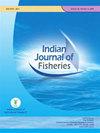Estimation and management of shrimp processing waste in organised shrimp processing sector in India: Opportunities and challenges
IF 0.3
4区 农林科学
Q4 FISHERIES
引用次数: 0
Abstract
This study was conducted to estimate the magnitude of processing waste produced in theorganised shrimp processing sector of India in order to assess the opportunities availablefor its utilisation. The estimation of magnitude of shrimp processing waste was based onsecondary data and its management was based on primary data collected through surveysat processing plants. The organised shrimp processing sector in India generated a largevolume of shrimp processing waste at a growth rate of 12% during 2000-2018. The quantityof shrimp processing waste generated ranged from 1.2 to 4.6 lakh t, which can be utilisedto produce 6712 to 27453 t of chitin alone. However, our study indicated that 75% of thetotal waste generated remained either unused or managed unscientifically, even when thereis huge demand for chitin and its derivatives in the domestic as well as in the internationalmarket. The case studies from chitin producing plants revealed that some costs wereincurred in the procurement of shrimp processing waste as a secondary raw material for theproduction of chitin. Thus forming a link between shrimp processing plants and chitin and itsderivatives producing plants would improve the supply of quality raw material and improveutilisation of processing wastes. The number of chitin and its derivatives producing plantsare too few in India to fully accommodate the large volume of shrimp processing wastegenerated every year. Therefore, infrastructure development in the chitin and associatedindustry with active support from government organisations to overcome the burden of initialinvestment is needed urgently, which can in turn encourage entrepreneurship developmentin the sector for diversified applications. Keywords:Chitin, Chitosan, Glucosamine hydrochloride,Growth rate, Waste utilisation印度有组织对虾加工部门对虾加工废弃物的估算和管理:机遇与挑战
本研究旨在估算印度有组织虾类加工行业产生的加工废物量,以评估其利用机会。对虾加工废弃物数量的估算基于二手数据,而对虾加工废弃物的管理则基于通过调查加工厂收集到的一手数据。2000-2018 年间,印度有组织的对虾加工行业产生了大量对虾加工废弃物,增长率为 12%。对虾加工废弃物的产生量从 120 万吨到 46 万吨不等,仅这些废弃物就可用于生产 6712 吨到 27453 吨甲壳素。然而,我们的研究表明,即使国内和国际市场对甲壳素及其衍生物有着巨大的需求,所产生的废物总量中仍有 75% 未被利用或管理不科学。甲壳素生产厂的案例研究表明,在采购虾加工废弃物作为生产甲壳素的次级原料时会产生一些成本。因此,在对虾加工厂和甲壳素及其衍生物生产厂之间建立联系将改善优质原料的供应,提高加工废料的利用率。印度的甲壳素及其衍生物生产厂数量太少,无法完全容纳每年产生的大量对虾加工废料。因此,当务之急是在政府组织的积极支持下发展甲壳素及其相关产业的基础设施,以克服初期投资的负担,进而鼓励该行业的创业发展,实现多元化应用。关键词:甲壳素 甲壳素 葡萄糖胺盐酸盐 增长率 废物利用
本文章由计算机程序翻译,如有差异,请以英文原文为准。
求助全文
约1分钟内获得全文
求助全文
来源期刊

Indian Journal of Fisheries
FISHERIES-
CiteScore
0.90
自引率
20.00%
发文量
0
审稿时长
6-12 weeks
期刊介绍:
Indian Journal of Fisheries is published quarterly by the Indian Council of Agricultural Research (ICAR), New Delhi. Original contributions in the field of Fish and fisheries science are considered for publication in the Journal. The material submitted must be unpublished and not under consideration for publication elsewhere.
Papers based on research which kills or damages any species, regarded as thratened/ endangered by IUCN crieteria or is as such listed in the Red Data Book appropriate to the geographic area concerned, will not be accepted by the Journal, unless the work has clear conservation objectives.
 求助内容:
求助内容: 应助结果提醒方式:
应助结果提醒方式:


